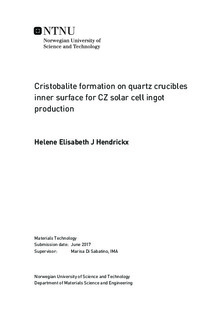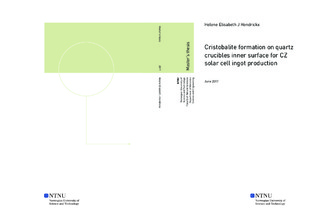| dc.description.abstract | Cristobalite, the stable high temperature polymorph of quartz, is formed on the surface of fused quartz crucibles used for the growth of monocrystalline silicon ingots by the Czochralski process. When not controlled and occurring locally, cristobalite can flocculate and enter the melt introducing possible defects and structure losses at the solidification front. This is detrimental to the quality of the silicon ingot. One way to suppress the release of cristobalite particles in the silicon melt is to promote the formation of a homogeneously distributed cristobalite layer on the crucible surface. This protective shell is obtained by coating or doping the crucible surface with a devitrification agent.
This work aims to understand the growth of cristobalite and the factors influencing it. Three different crucible types (A, B and Std) have been investigated. They differ by their quartz sand properties. Crucible pieces before their use in the CZ process and after their use, respectively coated by the crucible manufacturer or non coated have been studied.
Some new non coated crucible pieces have been covered with a barium based devitrification agent by different techniques. Heat treatments in a vertical gradient freeze (VGF) furnace and a CZ puller have been performed on new crucible rods (non coated, coated by the industry and coated at NTNU) as an attempt to reproduce industrial conditions and study the influences of the heat treatment type, the holding time at high temperature, the crucible sand quality and the presence and type of the coating. Samples of the resulting crucible pieces have been analysed by optical microscopy, scanning electron microscopy and X-ray diffraction in order to obtain informations about the cristobalite occurrence (e.g. layer thickness, crystal composition and orientation, morphology). A comparison with the results from the used crucible pieces has been made.
The results suggest that the cristobalite formation is influenced by many factors such as the coating pattern, homogeneity and thickness, the holding time at high temperature and the interactions at the melt/crucible surface interface. The spray coating technique is more suitable to obtain a homogeneous coating on the crucible surface even if the coating is easily removed by the handling procedures. Cristobalite nucleates faster on coated crucibles pieces and the layer formed is thicker and more homogeneous. The coating also seems to influence the orientation of the cristobalite growth. The longer the holding time at high temperature, the thicker and more homogeneously spread the cristobalite layer is, independently of the coating presence. In addition, the cristobalite layer nucleated tends to end up with the orientation \{200\} when enough time at high temperature is given. The contact with the melt during the heat treatment induces a dissolution of the quartz material and once formed, of the cristobalite layer as well. The cristobalite nucleation direction is also influenced by the contact with the melt. Std crucible shows non conclusive results while B crucible has the most coherent ones and seems to be the most suitable choice of crucible materials for the CZ process. | |

